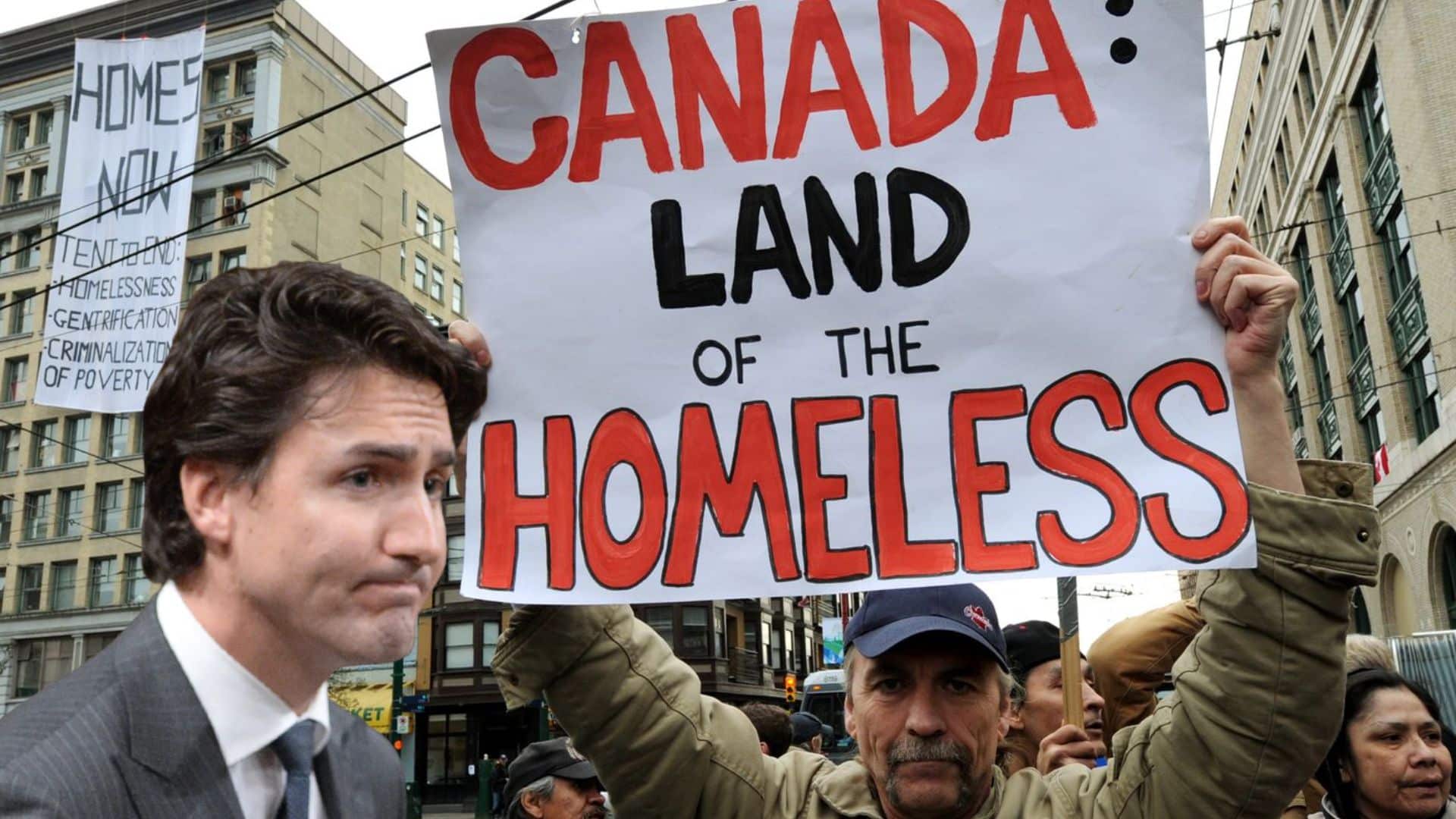News
Trudeau’s Canada a House of Cards Waiting to Collapse

Canada is under a state of toxicity. It’s unfashionable to say so in centrist circles, but it’s true. The country faces escalating radicalism, toxic polarisation, and low trust. Wealth disparity is increasing. Its federal system could be better, notably in the relationship between Alberta and the national government. Monopolies and oligopolies go amok, exploiting customers.
There are numerous other issues. However, the convergence of a few big obstacles screams House of Cards collapsing! The country’s housing crisis, consumer debt, and high – and potentially rising – interest rates are among them.
They present a picture of hardworking individuals living lives they can’t afford daily. This dreadful scenario occurs no matter how hard people work or how strictly they adhere to the game’s rules – laws they were assured were fair and just.
The Exorbitant Cost of Housing
In Canada, housing is completely expensive. The average home costs around CAD$700,000, while a one-bedroom rental costs close to $1,900 per month.
According to the Canadian Centre for Policy Alternatives, the hourly wage required to rent a one-bedroom flat exceeds the provincial minimum wage. The analysis discovered only three urban regions in Quebec where the minimum wage was more than the rent for a one-bedroom flat.
Housing starts — breaking ground on new buildings — are falling behind as the country booms. They were down 10% in July after a significant increase in June.
No Affordable Homes in Canada
According to the CMHC, the country needs 5.8 million homes by 2030 to achieve affordability, but construction is on track to reach only 2.8 million, less than half of what is required. Building costs, government policies, and labor shortages impede construction attempts.
Even when units are produced, there are far too few purpose-built rentals and non-market options to assist people needing affordable housing.
Those who are lucky enough to own a home face their own set of challenges. Mortgage payments are growing due to high-interest rates, which may climb again in the autumn. Now, 40% of mortgage holders borrow to cover day-to-day expenditures, and nearly 20% need to catch up on their payments.
According to Robert McLister of the Globe and Mail, that is based on data from December, and things have most likely worsened since then. Despite new measures from the Financial Consumer Agency of Canada aimed at keeping people in their houses and pricey financial gimmicks such as extra-long mortgage amortization periods, the prospect of default looms.
However, something has to give at this rate — especially since debtors will face renewal periods and high-interest rates in the coming months and years.
Canadians Floundering in Debt
Households are also heavily in debt. The CMHC cautioned in May that Canada’s household debt, which leads the G7 and will reach 107 percent of GDP in 2021, “makes the economy vulnerable to any global economic crisis.” It also puts it vulnerable to an internal crisis of its own making.
Mortgages account for most household debt, although auto loans and credit cards also contribute. Consumer debt in Canada reached a new high of $2.32 trillion in the spring. People need to catch up on their payments. Simultaneously, inflation and rising prices remain.
The Bank of Canada raised interest rates by 25 basis points to 5% in July, largely due to mortgage expenses, which were the key inflation drivers in June and July. As it struggles to achieve its 2% inflation objective, the bank may raise rates again in September.
In the near term, the bank and Canadians are locked in a vicious mortgage-inflation circle in which mortgage rates fuel inflation, and the bank boosts interest rates to combat inflation, which raises mortgage costs. Even if the long-term goal is to reduce inflation by limiting money supply and expenditure, the short-term spiral is hell.
It will take a long time to reach the 2% inflation target. Meanwhile, Canadians are in a precarious position with high mortgage rates, a lack of home supply, high prices, and a massive consumer debt burden.
As interest rates climb, so does the likelihood and possible number of mortgage, auto loan, and credit card defaults. The chance of job loss is similar.
The Austerity Dance of Justin Trudeau
The Bank of Canada is not mandated nor disposed to care about persons in financial difficulty in the short term. Its long-term goal is to keep inflation at a sustainable level. On the other hand, national, provincial, and local governments are supposed to care about those in need at all times. And yet, if there is a plan in place to protect Canada’s house of cards from collapsing or to make people whole, if it does, it is still being determined what that plan is.
Imperfect and insufficient social welfare programs, such as dental care and prescription drug coverage, are being implemented, but they are insufficient to address Canada’s serious financial crisis.
The Liberal government of Justin Trudeau may also be considering budget cuts. Ministers have been directed to cut $15 billion in spending by October. This could indicate a government less willing to spend significantly in the coming months and years, even as the Liberals sag in the polls and face an election in the autumn of 2025 or sooner.
Governments must be prepared to support individuals experiencing economic difficulty and will be crushed if the country’s house of cards collapses.
These folks work and strive for the things they’ve been instructed to strive for: a house, a car, an education, and a few respectable consumer goods. They are now abandoned due to a confluence of economic systems, pandemic repercussions, inefficient government policies, and unpredictable global geopolitical processes.
These employees, who ensure the buses run on time and the grocery shelves are filled, make up 40% of the country’s wages yet own only 2.7 percent of its net worth. In contrast, the wealthiest 20% of income controls about 70% of the total.
This wealth disparity is terrible at any time, but it’s especially disgusting in the aftermath of the last few years when the powers that be paid so much lip service to workers — as “frontline” and “essential.” They must not be abandoned in the wilderness while the country fights to resolve its economic problems.
This article by By David Moscrop was first published in Jacobin.com
News
Britain Must Be Ready for War in 3 Years, Warns New Army Chief

The new head of the Army has stated that Britain must be prepared to fight a war within three years.
Gen Sir Roland Walker has issued a warning about a variety of risks in what he calls a “increasingly volatile” environment.
However, he stated that war was not inevitable and that the Army had “just enough time” to prepare to prevent conflict.
He stated that the Army’s fighting capacity would be doubled by 2027 and tripled by the end of the decade.
Gen Walker warned that the Britain was under threat from a “axis of upheaval” in his first speech as Prime Minister on Tuesday.
Among the primary concerns confronting the Britain in the next years, as noted by the general in a briefing, is an enraged Russia, which may seek vengeance on the West for helping Ukraine, regardless of who wins the war.
He stated: “It doesn’t matter how it finishes. I believe Russia will emerge from it weaker objectively – or completely – but still very, very dangerous and seeking some form of retaliation for what we have done to assist Ukraine.”
Britain’s Government Defence Review and Military Challenges
He also warned that China was determined to retake Taiwan, and Iran was likely to seek nuclear weapons.
He stated that the threats they posed may become particularly acute in the next three years, and that these countries had formed a “mutual transactional relationship” since the war in Ukraine, sharing weaponry and technology.
However, he stated that the path to conflict was not “inexorable” if the UK re-established credible land troops to assist its deterrent strategy for avoiding war.
In his speech, he described his force of slightly over 70,000 regular troops as a “medium-sized army” and made no direct call for additional resources or men.
However, he pushed the British Army to adapt swiftly, focussing on technology such as artificial intelligence and weaponry rather than numbers.
His ultimate goal is for the Army to be capable of destroying an opponent three times its size.
This would entail firing quicker and farther, he said, aided by lessons learnt from the Ukraine war.
The general’s speech at the Royal United Services Institute land warfare conference comes only one week after the government began a “root and branch” defence review to “take a fresh look” at the challenges facing the armed services.
Defence Secretary John Healey launched the assessment, describing the existing status of the armed forces as “hollowed-out” and stating that “procurement waste and neglected morale cannot continue”.
According to the most recent Ministry of Defence (MoD) numbers from April 2024, the Britain’s regular Army forces total 75,325 troops (excluding Gurkhas and volunteers).
That figure has been declining in recent years, as recruiting has failed to match retention. The previous Conservative administration lowered the planned headcount from 82,000 to 72,500 by 2025.
Members of the NATO military alliance have agreed to spend at least 2% of GDP on defence by 2024, but several countries are unlikely to fulfil this goal.
The Britain presently spends 2.3% of its GDP on defence. Prime Minister Sir Keir Starmer has previously stated that the defence review will include a “roadmap” for increasing this to 2.5%, however he has yet to provide a date for this promise.
Source: BBC
News
Katie Ledecky Hopes For Clean Races At Paris Olympics In The Aftermath Of The Chinese Doping Scandal

PARIS — Katie Ledecky is looking for clean Olympic races. On Wednesday, Hope had pretty much reached her limit.
The American swimmer hopes to add to her six gold medals as she competes in the 400, 800, and 1,500 meters at the Paris Games. Her program starts with the heavy 400 on Saturday, featuring Ariarne Titmus and Summer McIntosh.

Katie Ledecky | ESPN Image
Katie Ledecky Hopes For Clean Races At Paris Olympics In The Aftermath Of The Chinese Doping Scandal
The 27-year-old Katie is competing in her fourth Summer Olympics, but the first since a doping scandal involving almost two dozen Chinese swimmers who tested positive for a banned chemical before the Tokyo Games — yet were permitted to compete with no consequences. The controversy has raised serious worries regarding the effectiveness of anti-doping initiatives.

Katie Ledecky | Vogue Image
“I hope everyone here is going to be competing clean this week,” Ledecky claimed. “But what truly counts is, were they training cleanly? Hopefully this has been the case. Hopefully, there has been worldwide testing.”
The International Olympic Committee has expressed concern over the ongoing US investigation into possible doping by Chinese swimmers. While awarding the 2034 Winter Olympics to Salt Lake City on Wednesday, the IOC urged Utah officials to do whatever they could to stop the FBI investigation.
“I think everyone’s heard what the athletes think,” Katie added. “They seek transparency. They want more answers to the remaining questions. At this point, we are here to race. We are going to race whoever is in the lane next to us.
“We are not paid to conduct the tests, so we trust those who follow their regulations. That applies both today and in the future.

Katie Ledecky | ESPN Image
Katie Ledecky Hopes For Clean Races At Paris Olympics In The Aftermath Of The Chinese Doping Scandal
SOURCE | AP
News
London Heatwave Alert: High Temperatures Set to Soar to 29C Next Week

As the summer holidays begin, London may experience an official heatwave with temperatures reaching up to 29 degrees Celsius.
The Met Office predicts a long period of sunny and dry weather for London after a soggy spring and summer.
After a cloudy day on Saturday, temperatures are expected to reach 27C on Sunday, with lots of sunlight.
On Monday and Tuesday, temperatures are forecast to peak at 29 degrees Celsius. Monday is forecast to offer more sunlight, while Tuesday may see some gloomy weather.
Temperatures are expected to remain in the high 20s next week, with lows of approximately 18C.
According to the Met Office, a heatwave is “an extended period of hot weather relative to the expected conditions of the area at that time of year, which may be accompanied by high humidity.”
In the United Kingdom, a heatwave is proclaimed when daily temperatures meet or surpass a certain level for at least three consecutive days.
In London, the heatwave threshold is 28 degrees Celsius.
The Met Office reported that the UK is experiencing hotter and wetter weather on average due to climate change.
The UK experienced its warmest May and April on record this year, despite damp and dismal conditions in many areas.
According to the Met Office’s State Of The UK Climate 2023 report published on Thursday, the UK experienced historic levels of extreme weather last year.
In the United Kingdom, 2023 was the second warmest year on record, bringing storms, flooding, strong heatwaves, and rising sea levels; only 2022 was warmer.
It was 0.8°C higher than the average from 1991 to 2020, and 1.66°C higher than the 1961 to 1990 average.
However, 2023 will be a “cool year” in comparison to 2100, based on the planet’s warming trajectory.
The government’s plan to adapt to the hazards presented by climate change is currently being challenged in the High Court by campaigners who allege the Tory administration’s July 2023 National Adaptation Programme (NAP) fails to adequately address 61 concerns.
Source: The Standard
-
World2 weeks ago
Former President Trump Survives Being Shot at Pennsylvania Rally
-
Tech4 weeks ago
Huawei Launches 5G-A Pioneers Program at MWC Shanghai 2024: Paving the Way for a Connected Future
-
Sports4 weeks ago
NBA Draft: Kyle Filipowski Withdraws Unexpectedly From The First Round
-
Tech4 weeks ago
ChatGPT Answers Undiscovered Questions and Outperforms Students.
-
News4 weeks ago
US Supreme Court Rejects Drug Deal that Protects the Sackler Family
-
Health4 weeks ago
US Health Agency Issues Dengue Virus Infection Warning


















